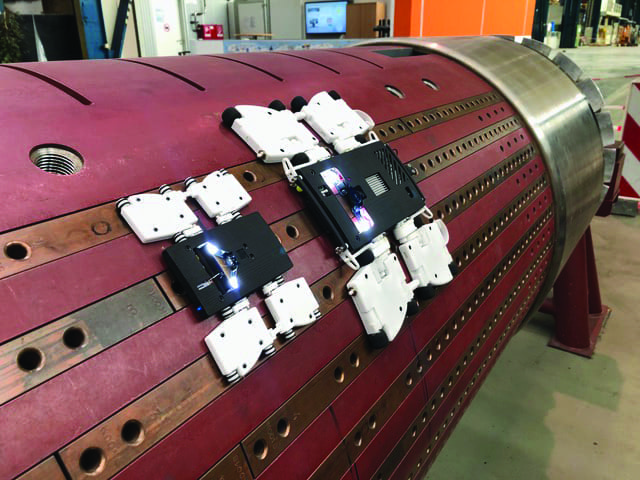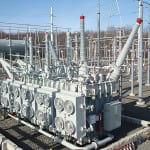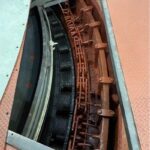Inspecting generators has always been a time-consuming and expensive job, yet one that needs to be done at regular intervals. An impressive new visual inspection robot can save owners many days of unnecessary downtime and hundreds of hours of work.
Performing thorough generator inspections at regular intervals is vital to the continued safe and efficient operation of a power plant, so it is a regime that cannot be neglected. One of the most challenging elements of any inspection is to examine the internal workings, such as the stator and rotor. Performing the work with a robot can save time and money, but there are limiting factors that can make accessing the generator with a robot troublesome. One of these aspects is the gap between the stator and the retaining ring, which can be as little as 20 millimeters (mm).
To answer these challenges, two years ago the SDO Industrial Generator Service Unit and the SPG Non-Destructive Test department at Siemens began collaborating on a project to provide a more efficient inspection method for smaller generators. The brief was reasonably open, but the aim was clear—operators wanted to avoid the downtime and cost that was associated with the traditional method of disassembly and visual inspection. A feasibility study was undertaken that considered infrared, endoscopy, and mirrors with the conclusion that a miniature robot was the best way forward. So, the project team began to develop the Visual Inspection Robot (VIR).
The initial idea was a small flat remote-controlled car. This was controlled over Wi-Fi and had an inexpensive USB endoscope of the front that was purchased from Amazon along with a small centrally mounted camera. The camera was looking onto a mirror that could be turned in any direction by a small servo motor. The chassis itself was magnetically attached to the rotor by two small magnets with wheels that facilitated forward, reverse, and sideways movement.
Rapid Development with Additive Manufacturing
In the past this type of project would have suffered from a lengthy timeline, but in the age of 3D printing the development team was able to instantly design and produce parts for prototypes. This rapid product development enabled the project to be validated within a couple of weeks, and funding was secured to develop commercial versions of the robot soon thereafter.
Over time, the team continued to improve the drive, magnets, and connectivity, while also ensuring that the VIR remained within the tight size constraints that would enable it to squeeze into the generator without the need for disassembly. The maximum height was set at 20 mm, which research showed would enable it to function in most of the turbine generators currently in operation.
To begin an inspection, the VIR is inserted into the generator by means of a selfie stick with magnetic plates attached. The tool is somewhat similar to a peel used to place and move pizzas in an oven, and it allows sliding the unit over the non-magnetic retaining ring. The VIR then navigates off that metal plate onto the rotor.
All generators contain components with varying magnetic properties. For example, the copper wiring is non-magnetic, so the trick for the inventors was to find the right magnetic configuration so that the VIR did not fall off regardless of the position it was in. The VIR needed to move along the entire lateral surface of the generator rotor, moving 360 degrees in any direction—forward, backward, sideways, diagonally, and even upside-down, which required considerable testing and improvement.
A Choice of Driving Styles
The robot drives along the rotor so that the entire surface of the rotor and stator can be checked for damage. The smart controller and drive units permit a 360-degree inspection without any further manual intervention on the part of the fact finder. A special wireless protocol allows the VIR to operate wirelessly, while still ensuring full high-definition (HD) image quality. The total height of the robot is a mere 19 mm, which allows it to be easily deployed in most generators (Figure 1). The unique motor drive layout enables the VIR to move freely along the lateral surface of the generator rotor. Diagonal travel and turning in place thus become helpful maneuvers.
 |
|
1. Two Virtual Inspection Robot (VIR) models are shown here mounted on a generator rotor in a shop. Courtesy: Siemens |
There are two options when it comes to piloting the VIR. It can either be driven manually to gather a quick status overview, or it can operate in fully automated mode by autonomously following the visible edge between a generator wedge and the rotor main body. The initial concept was for the VIR to be manual, but it became apparent that there were advantages in having autonomous driving options. In manual mode the VIR drives like a tank with the two sides controlled independently so that it moves forward, backward, or sideways by alternating both speeds. The advantage of the autonomous driving mode is that the specialist can study the images in real time, rather than having to concentrate on controlling the robot. The pictures are transmitted with low latency so the inspector can view the results as they are scanned.
An Impressive First Outing
All this effort finally came to fruition in October 2019 when the project team successfully deployed the robot commercially for the first time on a built-in generator in Asia. The customer was incredibly pleased with the technical implementation and the significant time savings compared to dismantling.
During the inspection, it was discovered using the VIR that there was a problem with condensation. This was evidenced by the presence of rust (Figure 2). The VIR is operated by a specialist who can interpret the images instantly, allowing timely feedback to be delivered to the customer. During this assessment, the specialist determined that the condensation problem was based on the temperature and the humidity in the region, and was able to discuss different ways to control the temperature when the generator was not in operation.
 |
|
2. This image shows areas of corrosion that were identified inside a generator using the VIR. Courtesy: Siemens |
Rusting is not the only discrepancy that a visual inspection can identify. When a generator suffers local short circuit events, it leaves slight discolorations—the area affected has a blue tint to it. Another crucial check is that all the cooling holes are unobstructed, this is especially important in smaller generators that rely on air cooling to control their temperature.
Adding Intelligence to the Robotic Platform
At present, the VIR relies on the experience and knowledge of the inspector, but there are plans to incorporate added intelligence to the platform. The robot and robot inspection are being continuously refined, and the development team is collaborating with the University of Heidelberg to enhance the process.
This work is being performed in four phases, the first of which is to develop an algorithm that generates a cohesive overall image of the inspected routes from the individual images of each video. The challenge here was overcoming the blurring effect on the images caused by the robot’s movement. The next step was to stitch those individual pictures taken by the robot into a “strip” representing the lateral surface of the stator or rotor.
With that established, the plan is to move on to some historical analysis. The team wants to be able to compare images from different inspections and have the program automatically highlight any changes. This is a task that is well-suited to a computer as opposed to manual detection by a specialist.
The final objective is pattern recognition, but to achieve this requires inspectors to build a library of similar images, which is lacking at present. This library of images needs to be taken from the same camera angle, with identical lighting and similar focus—all challenges that have yet to be overcome.
There are other inspection robots on the market but what makes the VIR unique is the ability to select its own route. Most of the other devices drive on the stator because this has a natural gap that can be used to guide the robot; they run essentially on a “train track,” held in position magnetically. The unique thing about the VIR is that users can drive anywhere they want to inside the generator. The other unique attribute is that the VIR is wireless—it has traditionally been challenging to get a signal out of 50 tons of copper.
When Size Matters
The present VIR is 300 mm x 300 mm and 19 mm high, the highest points are the wheels, and a level of clearance has been incorporated there. The overall size is determined by the parts that have been used. For example, the team wanted a 4K camera and video transmission capability, along with excellent lighting. Any reduction in size of these components comes with a resultant loss of performance, so it is a balancing act. It is the same for the motors and gearboxes, the smaller the design becomes, the less torque is available and the more strain the components are placed under, which results in an increased chance of failure.
The current version is designated as the first commercial version and Siemens has three sets of these—each set comprises two robots for redundancy. However, the company sees this as a case of continuous improvement. It will evaluate feedback from every job undertaken and the engineers will constantly enhance the robot. This process, again, is hastened by the ability that 3D printing gives the team to try and test things rapidly. One thing is already clear: this impressive robot can save users many days of unnecessary downtime and hundreds of hours of work on the part of the assembly team.
—Mirko Düsel is CEO Generation Service of Power Plants with Siemens, Thomas Hullmann is VIR project lead, Stefan Obermayr is VIR inventor, and Paul Dreischer is VIR software engineer.










